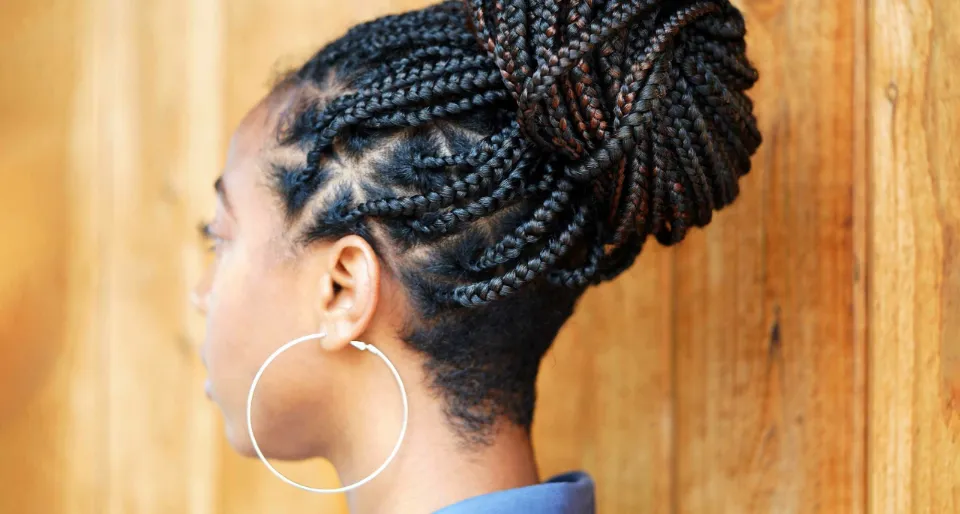If you are interested in knotless braids and wonder how to do knotless braids, this post is right for you.
Knotless braids is becoming the new standard in protective styles.
Check out everything you need to know before committing to knotless braids if your social media feeds are overflowing with cute knotless braid inspiration and you’re thinking about making them your next style.
What Are Knotless Braids?
Knotless braids have been around since the early 2000’s but after years of being on the fringe of hair braiding they’ve taken over. The term knotless references the knot used to start traditional box braids.
For classic box braids, the braider would tie a knot at the scalp by securing the braiding hair tightly. Your own hair is used to begin knotless braids, and the stylist gradually adds braiding hair.
Check our guide on How to Style Knotless Braids for more information.
Read More: What is An Inverted Bob?
How to Do Knotless Braids?

The good news is that there are lots of choices for knotless box braids. There are tiny knotless braids, medium-sized knotless braids, and large knotless braids. Additionally, the braids’ length is entirely up to you.
Here’s a quick step-by-step tutorial on how to do knotless braids.
Step 1: Cleanse the Hair
It’s crucial to start with clean hair when applying any braided style. Try using a sulfate-free shampoo like the Coco Creme Sulfate-Free Shampoo to remove product buildup, dirt, and debris from the hair without robbing it of its natural oils.
Step 2: Prep the Hair
Once the hair has been thoroughly cleaned and condition, detangle it to remove knots and tangles and let it air dry or blow dry it until it is completely dry.
Blowing the hair dry will facilitate installation and prevent the hair from tangling up while being braided.
Step 3: Section the Hair
Starting with perfect part creation is the first step to creating neat, knotless braids. It works best to divide the hair into four or six sections before doing this.
The size of the knotless braid you will make should be decided at this point. Make sure to maintain consistency between each section.
For all partings, it is best to use a rat tail comb. With the rat tail comb, create a square section (as small or large as you want) and then section all other hair away.
Step 4: Smooth Edges
You should apply pomade or gel at the roots of each sectioned braid to keep it neater for a longer period of time.
Step 5 for Knotless Box Braids: Create the Braids
Once the product is applied, it’s time to start braiding. Start a three-strand braid, just as you normally would. If you want to make the knotless braids with natural hair, braid it all the way to the end and then tie it off with a clear elastic.
When adding hair, first braid your natural hair one to three times at the root before starting to feed in the extra hair. It’s best to feed the hair into the braid in small sections to prevent unsightly knots or bulges.
Related Reading:
- How Long Do Knotless Braids Last?
- How to Take Care of Knotless Braids?
- How to Refresh Knotless Braids?
- How to Wash Knotless Braids?
Knotless Braids Techniques
Now, let’s take a look at the different techniques for creating knotless braids. There are several different methods, but the most popular ones include:
- Using a crochet needle and thread, you’ll secure the braids to your natural hair in this style. It’s a quick and simple method that works well for people who are short on time to make knotless braids.
- Using a latch hook to secure the braids to your natural hair is the latch hook technique. It takes a little bit longer than the crochet method, but it’s great for people who prefer a more precise appearance.
- The cornrow method entails making little, close braids that are then secured to your natural hair. It takes a little bit longer than the other techniques, but it’s ideal for those who prefer a more natural-looking look.
What’s the Difference Between Knotless Braids and Box Braids?
It’s crucial to understand that knotless braids are just another kind of box braid. The similarity in appearance results from this.
But a knotless braids style is exactly that—knotless, as the name suggests. Because kanekalon hair was inserted at the scalp to give the natural hair the necessary length and volume, the style does not have the noticeable knot that is created at the root.
Instead, that one larger piece of kanekalon is divided into smaller pieces and woven into the braids further down the shaft as opposed to at the root, creating a sleeker appearance.
That sleeker look is what makes knotless braids more versatile than other styles. When making other styles like ponytails, buns, and updos, the braids lie flatter because they are less bulky.
Why Do People Love Knotless Braids?
They’re painless. The painful tugging and tightness on your scalp when you first get traditional box braids done is one of their biggest drawbacks. There is none of that with this knotless technique. Nothing hurts on your knotless braids.
They’re not heavy. By feeding in the hair as you go down the braid you’ll get a braid that’s not as bulky, flows like real hair, and not as heavy on your head, meaning more hair flips!
Related Reading: Knotless Braids Vs Box Braids
Conclusion on How to Do Knotless Braids
Whatever method you select, it’s critical to keep in mind that patience and taking your time will yield the best results.
You will get perfect knotless braids after practice, have a try now!
Read More:
- What Are Peekaboo Knotless Braids?
- How to Do Waterfall Braids?
- How to Do French Braids?
- How to Do Vintage Curls?
FAQs
Is It Easier to Do Knotless Or Box Braids?
If your last experience of braiding your hair left you with memories of being up all night from the excruciating pain caused by the tension of the braids on your scalp, you’ll be pleased to know that knotless braids have a lot less tension on the scalp, which means a lot less pain.
What is the Easiest Braid to Learn on Yourself?
Classic Three-Strand Braid. This is undoubtedly where you should begin if you’re a beginner.
What Hair Do You Use for Knotless Braids?
We always recommend using human hair where possible.




